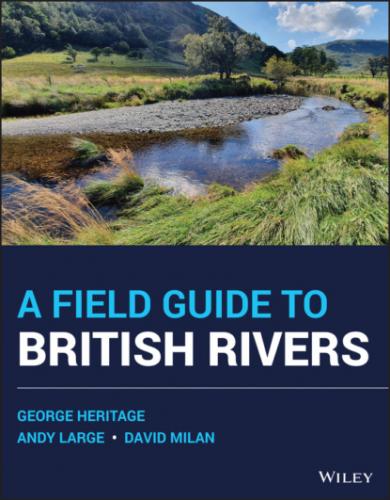A Field Guide to British Rivers. George Heritage
and rifles, resulting from oscillations in hydraulic conditions from convergent (erosive) to divergent (depositional) flow environments (typical spacing 5–15 channel widths). The gradient of such channels is low to moderate, and the width to depth ratio high. The bed is predominantly gravel with occasional patches of cobbles and sand. Accumulation of sediments in gravel bars indicates increasingly transport‐limited conditions, though most large floods will produce some bedload movement on an annual basis, thus reducing the stability of the channel. In such channels, interactions between the stream and the riparian zone become more obvious with extensive over‐bank flood flows and wetland areas often characterising the riparian zone. The banks are typically resistant to erosion, and lateral migration of the channel is limited, resulting in relatively narrow and intermittently deep channels. Plane‐riffle channels form an intermediate channel type between those of plane‐bed and pool‐riffle channels. They retain many of the attributes of pool‐riffle channels; however, they generally have less defined pools, coarser (armoured) substrate, and less‐extensive bar features. They are a common channel form in the United Kingdom, although it is unclear whether their presence is natural or whether they represent a degraded form of the pool‐riffle channel. For management purposes, it is suggested that they are treated as a pool‐riffle channel type.
A key issue arises when discussing the scale over which any classification system is applied. In Scotland, pool‐riffle units appear to have been subsumed into an “active meandering channel type” by SEPA (2012), whilst remaining explicit in many other classifications. Similarly, rapids and associated morphologic units become difficult to classify. Anabranching or anastomosed channels, which are often rare across temperate regions where the majority of the classifications have been developed, are also under‐represented in typologies with only the River Styles framework (Brierley and Fryirs 2005) explicitly considering this channel type, illustrating how geography has influenced the typologies.
Recognising the above and the absence of a “one size fits all” methodology, this book follows Montgomery and Buffington’s well‐established (1997) fluvial framework, expanding it where necessary to include rarer, but nonetheless important, river types encountered across the United Kingdom. We use this based on a collective 90 years’ plus of river science and river management experience in the authorship team, but particularly as this classification is fundamentally based around characteristic process controls (Table 2.5) and morphological assemblages which are summarised in Figure 2.5 and Tables 2.6 and 2.7 all of which are described in greater detail in Chapter 3.
Table 2.5 Basic character and processes operating in the channel types used in this book.
| Channel type | Processes |
|---|---|
| Diffuse Upland | Channels are characteristically small with steep organic or fine sediment bank profiles. The channel bed may be organic or fine sediment with occasional bedrock or boulder steps separating long pools upstream. Seasonal channels may be vegetated and generally are less well defined promoting diffuse surface flow. |
| Bedrock | Bedrock channels are most associated with mountain areas but can occur almost anywhere along a watercourse. They are morphologically robust and have a high flood competence. Valley bottom area is often narrow. Bedrock and/or boulder step pool sequences dominate with the steps acting to moderate gradient providing stable channel conditions. The pools often contain limited finer sediments due to the low‐energy conditions created by the backwater effects of the steps. |
| Wandering |
Wandering channel types are associated with upland zones. They are often found flowing across an extended valley floor in moderate‐to‐high gradient systems where sediment loads are high. Often, they are associated with relict fluvio‐glacial valley bottom material with the river forming several channels through a mix of sediment dominated by large material rarely mobilised by the |
